Cash Flow Budget: Analysis and Recommendations
VerifiedAdded on 2023/01/12
|7
|2078
|59
AI Summary
This report analyzes the cash flow budget of a company for the months of October, November, and December 2018 and provides recommendations for overcoming budget issues.
Contribute Materials
Your contribution can guide someone’s learning journey. Share your
documents today.
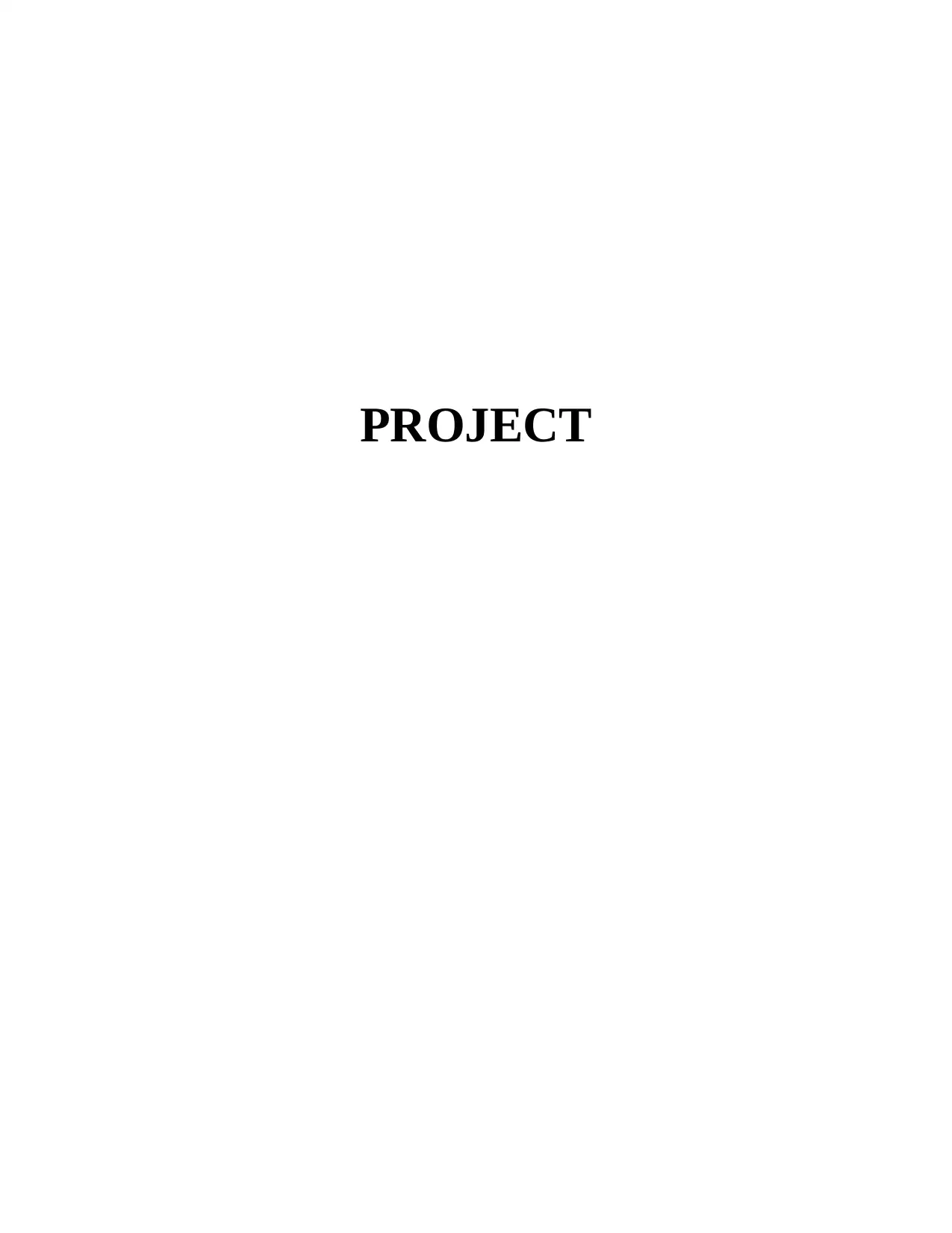
PROJECT
Secure Best Marks with AI Grader
Need help grading? Try our AI Grader for instant feedback on your assignments.
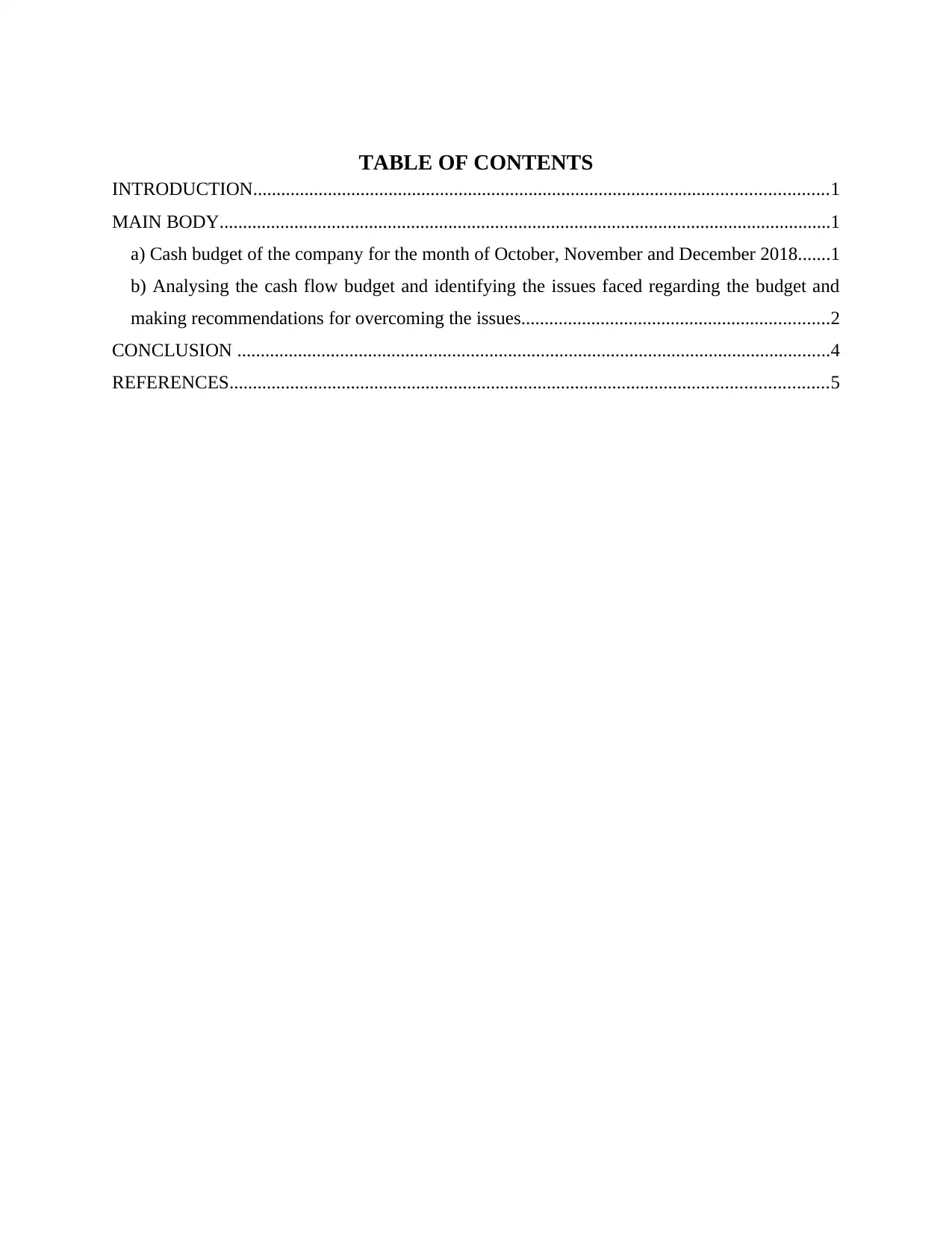
TABLE OF CONTENTS
INTRODUCTION...........................................................................................................................1
MAIN BODY...................................................................................................................................1
a) Cash budget of the company for the month of October, November and December 2018.......1
b) Analysing the cash flow budget and identifying the issues faced regarding the budget and
making recommendations for overcoming the issues..................................................................2
CONCLUSION ...............................................................................................................................4
REFERENCES................................................................................................................................5
INTRODUCTION...........................................................................................................................1
MAIN BODY...................................................................................................................................1
a) Cash budget of the company for the month of October, November and December 2018.......1
b) Analysing the cash flow budget and identifying the issues faced regarding the budget and
making recommendations for overcoming the issues..................................................................2
CONCLUSION ...............................................................................................................................4
REFERENCES................................................................................................................................5
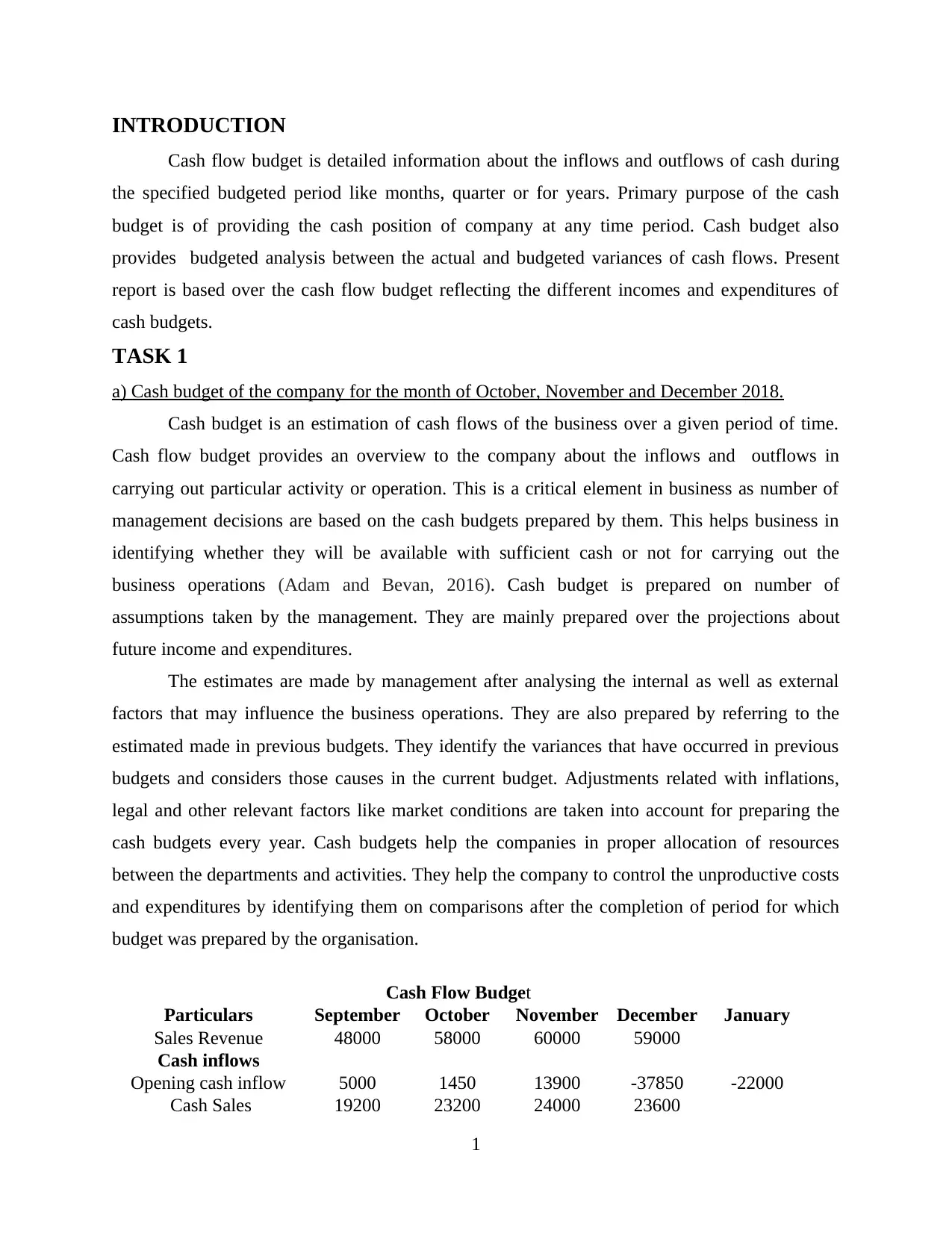
INTRODUCTION
Cash flow budget is detailed information about the inflows and outflows of cash during
the specified budgeted period like months, quarter or for years. Primary purpose of the cash
budget is of providing the cash position of company at any time period. Cash budget also
provides budgeted analysis between the actual and budgeted variances of cash flows. Present
report is based over the cash flow budget reflecting the different incomes and expenditures of
cash budgets.
TASK 1
a) Cash budget of the company for the month of October, November and December 2018.
Cash budget is an estimation of cash flows of the business over a given period of time.
Cash flow budget provides an overview to the company about the inflows and outflows in
carrying out particular activity or operation. This is a critical element in business as number of
management decisions are based on the cash budgets prepared by them. This helps business in
identifying whether they will be available with sufficient cash or not for carrying out the
business operations (Adam and Bevan, 2016). Cash budget is prepared on number of
assumptions taken by the management. They are mainly prepared over the projections about
future income and expenditures.
The estimates are made by management after analysing the internal as well as external
factors that may influence the business operations. They are also prepared by referring to the
estimated made in previous budgets. They identify the variances that have occurred in previous
budgets and considers those causes in the current budget. Adjustments related with inflations,
legal and other relevant factors like market conditions are taken into account for preparing the
cash budgets every year. Cash budgets help the companies in proper allocation of resources
between the departments and activities. They help the company to control the unproductive costs
and expenditures by identifying them on comparisons after the completion of period for which
budget was prepared by the organisation.
Cash Flow Budget
Particulars September October November December January
Sales Revenue 48000 58000 60000 59000
Cash inflows
Opening cash inflow 5000 1450 13900 -37850 -22000
Cash Sales 19200 23200 24000 23600
1
Cash flow budget is detailed information about the inflows and outflows of cash during
the specified budgeted period like months, quarter or for years. Primary purpose of the cash
budget is of providing the cash position of company at any time period. Cash budget also
provides budgeted analysis between the actual and budgeted variances of cash flows. Present
report is based over the cash flow budget reflecting the different incomes and expenditures of
cash budgets.
TASK 1
a) Cash budget of the company for the month of October, November and December 2018.
Cash budget is an estimation of cash flows of the business over a given period of time.
Cash flow budget provides an overview to the company about the inflows and outflows in
carrying out particular activity or operation. This is a critical element in business as number of
management decisions are based on the cash budgets prepared by them. This helps business in
identifying whether they will be available with sufficient cash or not for carrying out the
business operations (Adam and Bevan, 2016). Cash budget is prepared on number of
assumptions taken by the management. They are mainly prepared over the projections about
future income and expenditures.
The estimates are made by management after analysing the internal as well as external
factors that may influence the business operations. They are also prepared by referring to the
estimated made in previous budgets. They identify the variances that have occurred in previous
budgets and considers those causes in the current budget. Adjustments related with inflations,
legal and other relevant factors like market conditions are taken into account for preparing the
cash budgets every year. Cash budgets help the companies in proper allocation of resources
between the departments and activities. They help the company to control the unproductive costs
and expenditures by identifying them on comparisons after the completion of period for which
budget was prepared by the organisation.
Cash Flow Budget
Particulars September October November December January
Sales Revenue 48000 58000 60000 59000
Cash inflows
Opening cash inflow 5000 1450 13900 -37850 -22000
Cash Sales 19200 23200 24000 23600
1
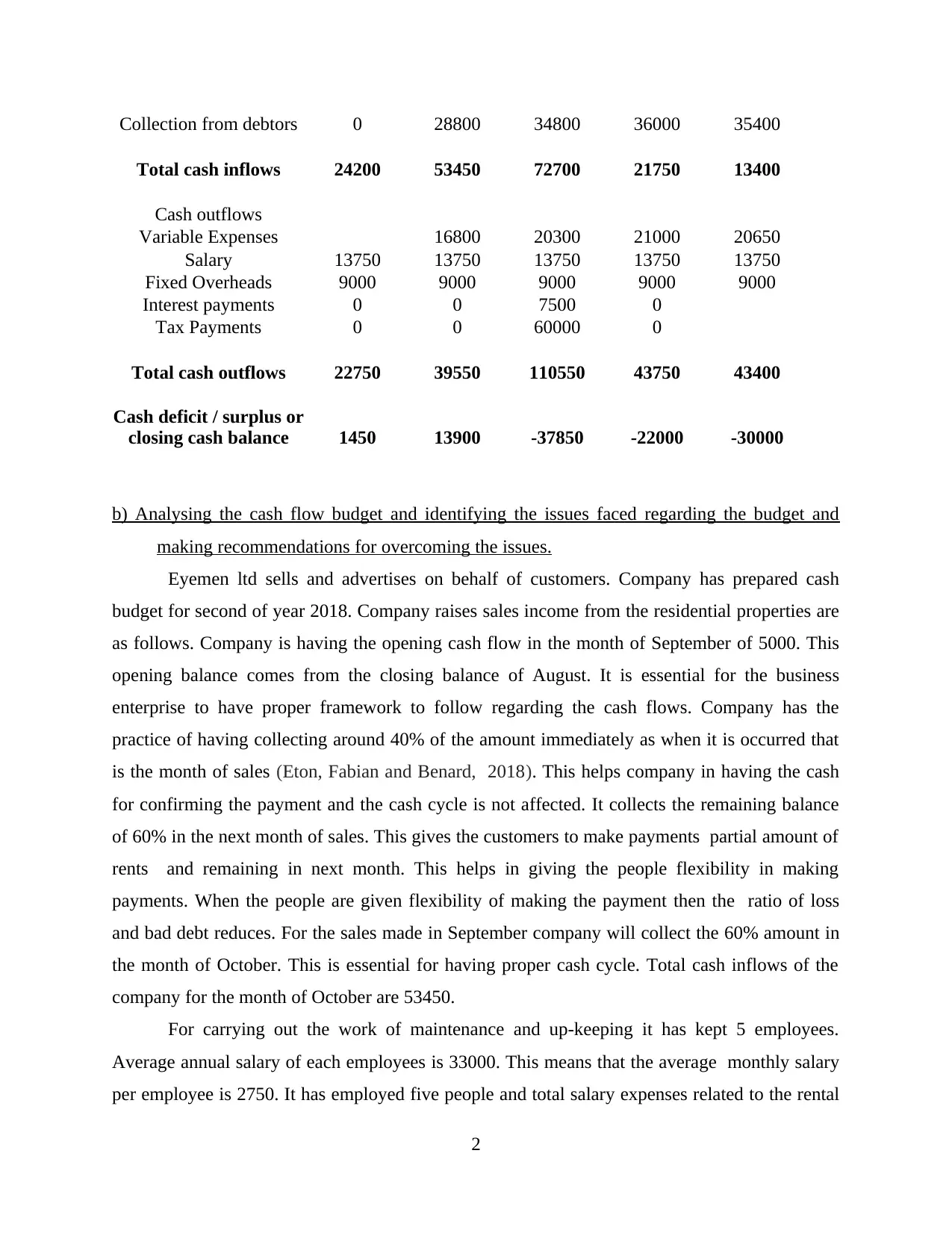
Collection from debtors 0 28800 34800 36000 35400
Total cash inflows 24200 53450 72700 21750 13400
Cash outflows
Variable Expenses 16800 20300 21000 20650
Salary 13750 13750 13750 13750 13750
Fixed Overheads 9000 9000 9000 9000 9000
Interest payments 0 0 7500 0
Tax Payments 0 0 60000 0
Total cash outflows 22750 39550 110550 43750 43400
Cash deficit / surplus or
closing cash balance 1450 13900 -37850 -22000 -30000
b) Analysing the cash flow budget and identifying the issues faced regarding the budget and
making recommendations for overcoming the issues.
Eyemen ltd sells and advertises on behalf of customers. Company has prepared cash
budget for second of year 2018. Company raises sales income from the residential properties are
as follows. Company is having the opening cash flow in the month of September of 5000. This
opening balance comes from the closing balance of August. It is essential for the business
enterprise to have proper framework to follow regarding the cash flows. Company has the
practice of having collecting around 40% of the amount immediately as when it is occurred that
is the month of sales (Eton, Fabian and Benard, 2018). This helps company in having the cash
for confirming the payment and the cash cycle is not affected. It collects the remaining balance
of 60% in the next month of sales. This gives the customers to make payments partial amount of
rents and remaining in next month. This helps in giving the people flexibility in making
payments. When the people are given flexibility of making the payment then the ratio of loss
and bad debt reduces. For the sales made in September company will collect the 60% amount in
the month of October. This is essential for having proper cash cycle. Total cash inflows of the
company for the month of October are 53450.
For carrying out the work of maintenance and up-keeping it has kept 5 employees.
Average annual salary of each employees is 33000. This means that the average monthly salary
per employee is 2750. It has employed five people and total salary expenses related to the rental
2
Total cash inflows 24200 53450 72700 21750 13400
Cash outflows
Variable Expenses 16800 20300 21000 20650
Salary 13750 13750 13750 13750 13750
Fixed Overheads 9000 9000 9000 9000 9000
Interest payments 0 0 7500 0
Tax Payments 0 0 60000 0
Total cash outflows 22750 39550 110550 43750 43400
Cash deficit / surplus or
closing cash balance 1450 13900 -37850 -22000 -30000
b) Analysing the cash flow budget and identifying the issues faced regarding the budget and
making recommendations for overcoming the issues.
Eyemen ltd sells and advertises on behalf of customers. Company has prepared cash
budget for second of year 2018. Company raises sales income from the residential properties are
as follows. Company is having the opening cash flow in the month of September of 5000. This
opening balance comes from the closing balance of August. It is essential for the business
enterprise to have proper framework to follow regarding the cash flows. Company has the
practice of having collecting around 40% of the amount immediately as when it is occurred that
is the month of sales (Eton, Fabian and Benard, 2018). This helps company in having the cash
for confirming the payment and the cash cycle is not affected. It collects the remaining balance
of 60% in the next month of sales. This gives the customers to make payments partial amount of
rents and remaining in next month. This helps in giving the people flexibility in making
payments. When the people are given flexibility of making the payment then the ratio of loss
and bad debt reduces. For the sales made in September company will collect the 60% amount in
the month of October. This is essential for having proper cash cycle. Total cash inflows of the
company for the month of October are 53450.
For carrying out the work of maintenance and up-keeping it has kept 5 employees.
Average annual salary of each employees is 33000. This means that the average monthly salary
per employee is 2750. It has employed five people and total salary expenses related to the rental
2
Secure Best Marks with AI Grader
Need help grading? Try our AI Grader for instant feedback on your assignments.
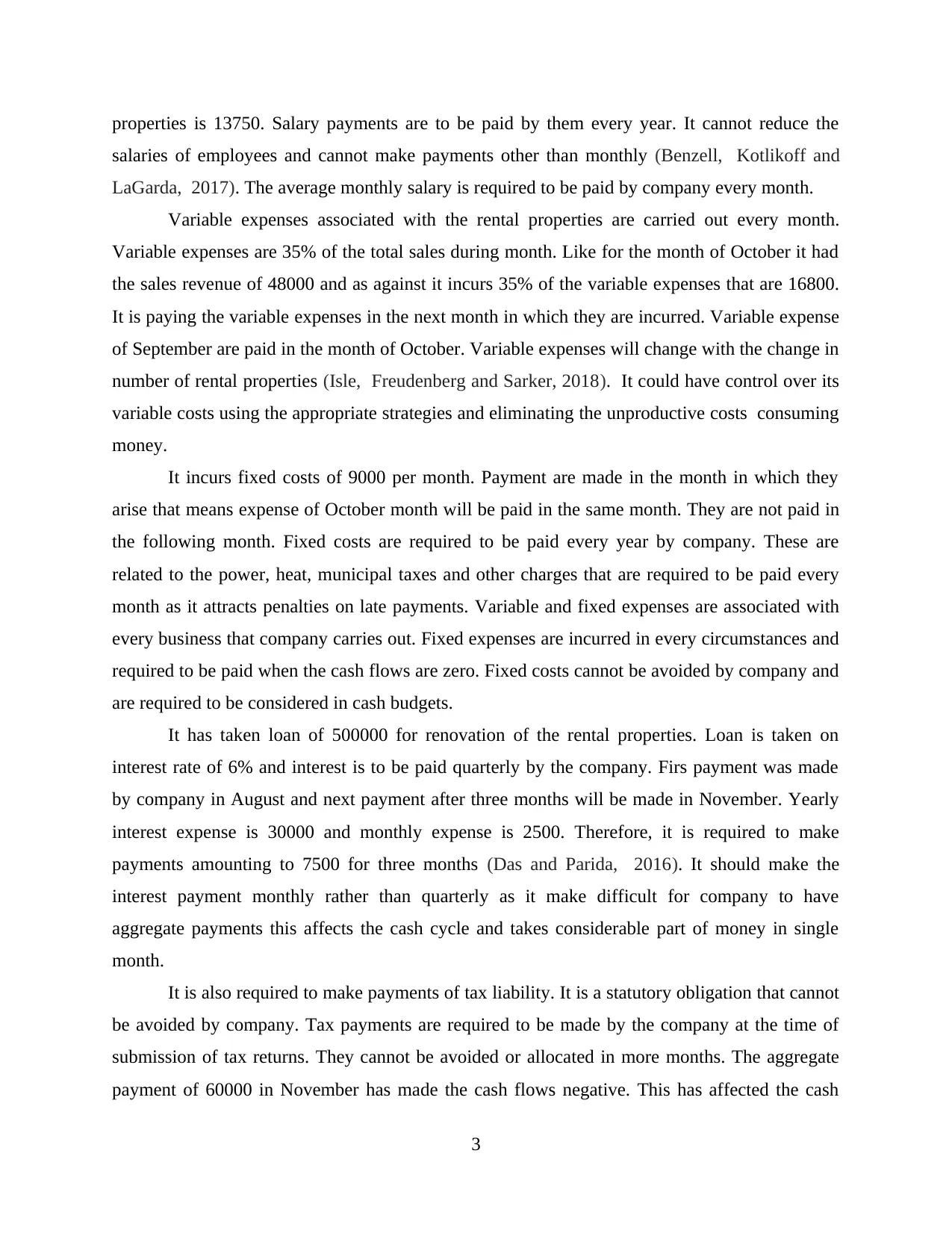
properties is 13750. Salary payments are to be paid by them every year. It cannot reduce the
salaries of employees and cannot make payments other than monthly (Benzell, Kotlikoff and
LaGarda, 2017). The average monthly salary is required to be paid by company every month.
Variable expenses associated with the rental properties are carried out every month.
Variable expenses are 35% of the total sales during month. Like for the month of October it had
the sales revenue of 48000 and as against it incurs 35% of the variable expenses that are 16800.
It is paying the variable expenses in the next month in which they are incurred. Variable expense
of September are paid in the month of October. Variable expenses will change with the change in
number of rental properties (Isle, Freudenberg and Sarker, 2018). It could have control over its
variable costs using the appropriate strategies and eliminating the unproductive costs consuming
money.
It incurs fixed costs of 9000 per month. Payment are made in the month in which they
arise that means expense of October month will be paid in the same month. They are not paid in
the following month. Fixed costs are required to be paid every year by company. These are
related to the power, heat, municipal taxes and other charges that are required to be paid every
month as it attracts penalties on late payments. Variable and fixed expenses are associated with
every business that company carries out. Fixed expenses are incurred in every circumstances and
required to be paid when the cash flows are zero. Fixed costs cannot be avoided by company and
are required to be considered in cash budgets.
It has taken loan of 500000 for renovation of the rental properties. Loan is taken on
interest rate of 6% and interest is to be paid quarterly by the company. Firs payment was made
by company in August and next payment after three months will be made in November. Yearly
interest expense is 30000 and monthly expense is 2500. Therefore, it is required to make
payments amounting to 7500 for three months (Das and Parida, 2016). It should make the
interest payment monthly rather than quarterly as it make difficult for company to have
aggregate payments this affects the cash cycle and takes considerable part of money in single
month.
It is also required to make payments of tax liability. It is a statutory obligation that cannot
be avoided by company. Tax payments are required to be made by the company at the time of
submission of tax returns. They cannot be avoided or allocated in more months. The aggregate
payment of 60000 in November has made the cash flows negative. This has affected the cash
3
salaries of employees and cannot make payments other than monthly (Benzell, Kotlikoff and
LaGarda, 2017). The average monthly salary is required to be paid by company every month.
Variable expenses associated with the rental properties are carried out every month.
Variable expenses are 35% of the total sales during month. Like for the month of October it had
the sales revenue of 48000 and as against it incurs 35% of the variable expenses that are 16800.
It is paying the variable expenses in the next month in which they are incurred. Variable expense
of September are paid in the month of October. Variable expenses will change with the change in
number of rental properties (Isle, Freudenberg and Sarker, 2018). It could have control over its
variable costs using the appropriate strategies and eliminating the unproductive costs consuming
money.
It incurs fixed costs of 9000 per month. Payment are made in the month in which they
arise that means expense of October month will be paid in the same month. They are not paid in
the following month. Fixed costs are required to be paid every year by company. These are
related to the power, heat, municipal taxes and other charges that are required to be paid every
month as it attracts penalties on late payments. Variable and fixed expenses are associated with
every business that company carries out. Fixed expenses are incurred in every circumstances and
required to be paid when the cash flows are zero. Fixed costs cannot be avoided by company and
are required to be considered in cash budgets.
It has taken loan of 500000 for renovation of the rental properties. Loan is taken on
interest rate of 6% and interest is to be paid quarterly by the company. Firs payment was made
by company in August and next payment after three months will be made in November. Yearly
interest expense is 30000 and monthly expense is 2500. Therefore, it is required to make
payments amounting to 7500 for three months (Das and Parida, 2016). It should make the
interest payment monthly rather than quarterly as it make difficult for company to have
aggregate payments this affects the cash cycle and takes considerable part of money in single
month.
It is also required to make payments of tax liability. It is a statutory obligation that cannot
be avoided by company. Tax payments are required to be made by the company at the time of
submission of tax returns. They cannot be avoided or allocated in more months. The aggregate
payment of 60000 in November has made the cash flows negative. This has affected the cash
3
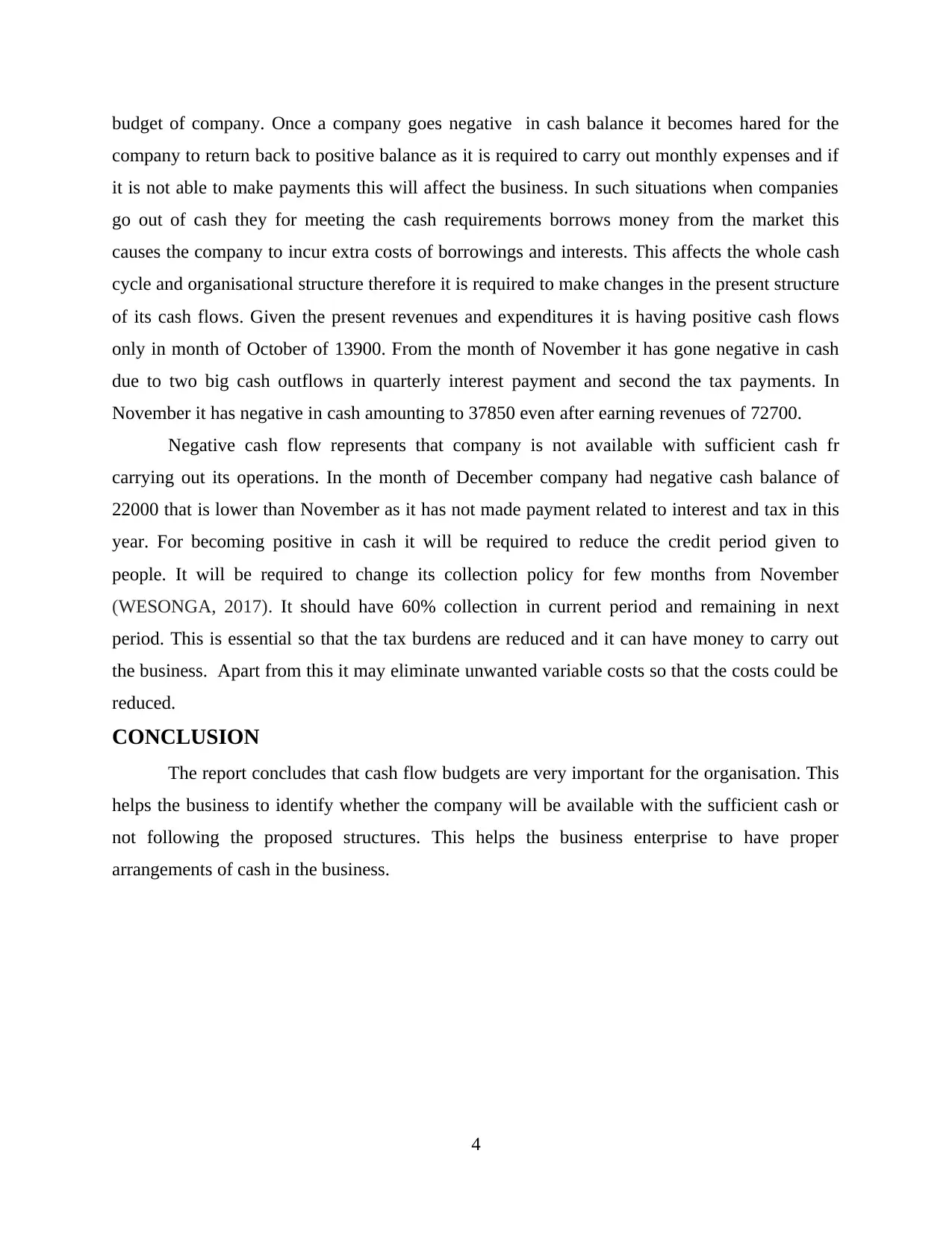
budget of company. Once a company goes negative in cash balance it becomes hared for the
company to return back to positive balance as it is required to carry out monthly expenses and if
it is not able to make payments this will affect the business. In such situations when companies
go out of cash they for meeting the cash requirements borrows money from the market this
causes the company to incur extra costs of borrowings and interests. This affects the whole cash
cycle and organisational structure therefore it is required to make changes in the present structure
of its cash flows. Given the present revenues and expenditures it is having positive cash flows
only in month of October of 13900. From the month of November it has gone negative in cash
due to two big cash outflows in quarterly interest payment and second the tax payments. In
November it has negative in cash amounting to 37850 even after earning revenues of 72700.
Negative cash flow represents that company is not available with sufficient cash fr
carrying out its operations. In the month of December company had negative cash balance of
22000 that is lower than November as it has not made payment related to interest and tax in this
year. For becoming positive in cash it will be required to reduce the credit period given to
people. It will be required to change its collection policy for few months from November
(WESONGA, 2017). It should have 60% collection in current period and remaining in next
period. This is essential so that the tax burdens are reduced and it can have money to carry out
the business. Apart from this it may eliminate unwanted variable costs so that the costs could be
reduced.
CONCLUSION
The report concludes that cash flow budgets are very important for the organisation. This
helps the business to identify whether the company will be available with the sufficient cash or
not following the proposed structures. This helps the business enterprise to have proper
arrangements of cash in the business.
4
company to return back to positive balance as it is required to carry out monthly expenses and if
it is not able to make payments this will affect the business. In such situations when companies
go out of cash they for meeting the cash requirements borrows money from the market this
causes the company to incur extra costs of borrowings and interests. This affects the whole cash
cycle and organisational structure therefore it is required to make changes in the present structure
of its cash flows. Given the present revenues and expenditures it is having positive cash flows
only in month of October of 13900. From the month of November it has gone negative in cash
due to two big cash outflows in quarterly interest payment and second the tax payments. In
November it has negative in cash amounting to 37850 even after earning revenues of 72700.
Negative cash flow represents that company is not available with sufficient cash fr
carrying out its operations. In the month of December company had negative cash balance of
22000 that is lower than November as it has not made payment related to interest and tax in this
year. For becoming positive in cash it will be required to reduce the credit period given to
people. It will be required to change its collection policy for few months from November
(WESONGA, 2017). It should have 60% collection in current period and remaining in next
period. This is essential so that the tax burdens are reduced and it can have money to carry out
the business. Apart from this it may eliminate unwanted variable costs so that the costs could be
reduced.
CONCLUSION
The report concludes that cash flow budgets are very important for the organisation. This
helps the business to identify whether the company will be available with the sufficient cash or
not following the proposed structures. This helps the business enterprise to have proper
arrangements of cash in the business.
4
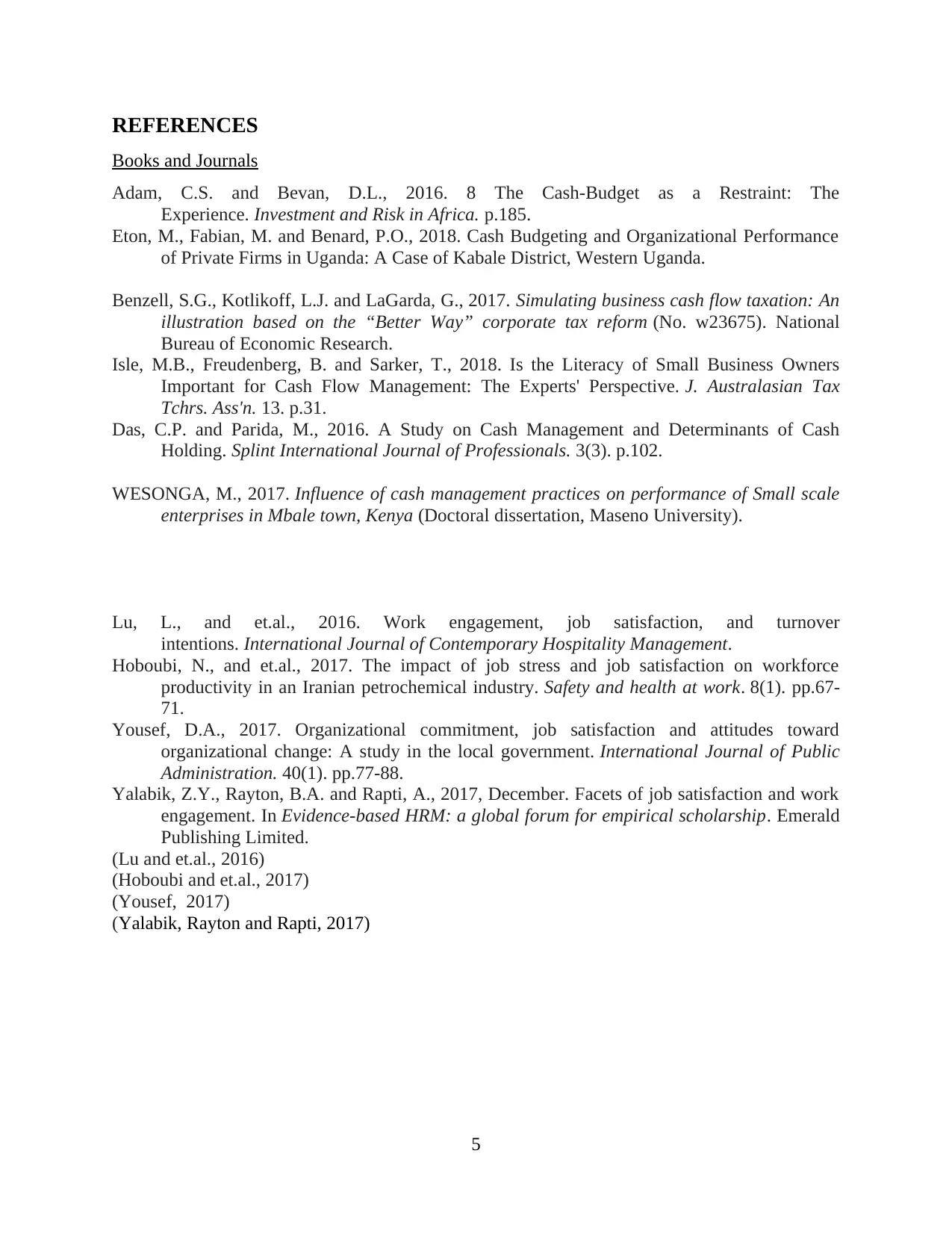
REFERENCES
Books and Journals
Adam, C.S. and Bevan, D.L., 2016. 8 The Cash-Budget as a Restraint: The
Experience. Investment and Risk in Africa. p.185.
Eton, M., Fabian, M. and Benard, P.O., 2018. Cash Budgeting and Organizational Performance
of Private Firms in Uganda: A Case of Kabale District, Western Uganda.
Benzell, S.G., Kotlikoff, L.J. and LaGarda, G., 2017. Simulating business cash flow taxation: An
illustration based on the “Better Way” corporate tax reform (No. w23675). National
Bureau of Economic Research.
Isle, M.B., Freudenberg, B. and Sarker, T., 2018. Is the Literacy of Small Business Owners
Important for Cash Flow Management: The Experts' Perspective. J. Australasian Tax
Tchrs. Ass'n. 13. p.31.
Das, C.P. and Parida, M., 2016. A Study on Cash Management and Determinants of Cash
Holding. Splint International Journal of Professionals. 3(3). p.102.
WESONGA, M., 2017. Influence of cash management practices on performance of Small scale
enterprises in Mbale town, Kenya (Doctoral dissertation, Maseno University).
Lu, L., and et.al., 2016. Work engagement, job satisfaction, and turnover
intentions. International Journal of Contemporary Hospitality Management.
Hoboubi, N., and et.al., 2017. The impact of job stress and job satisfaction on workforce
productivity in an Iranian petrochemical industry. Safety and health at work. 8(1). pp.67-
71.
Yousef, D.A., 2017. Organizational commitment, job satisfaction and attitudes toward
organizational change: A study in the local government. International Journal of Public
Administration. 40(1). pp.77-88.
Yalabik, Z.Y., Rayton, B.A. and Rapti, A., 2017, December. Facets of job satisfaction and work
engagement. In Evidence-based HRM: a global forum for empirical scholarship. Emerald
Publishing Limited.
(Lu and et.al., 2016)
(Hoboubi and et.al., 2017)
(Yousef, 2017)
(Yalabik, Rayton and Rapti, 2017)
5
Books and Journals
Adam, C.S. and Bevan, D.L., 2016. 8 The Cash-Budget as a Restraint: The
Experience. Investment and Risk in Africa. p.185.
Eton, M., Fabian, M. and Benard, P.O., 2018. Cash Budgeting and Organizational Performance
of Private Firms in Uganda: A Case of Kabale District, Western Uganda.
Benzell, S.G., Kotlikoff, L.J. and LaGarda, G., 2017. Simulating business cash flow taxation: An
illustration based on the “Better Way” corporate tax reform (No. w23675). National
Bureau of Economic Research.
Isle, M.B., Freudenberg, B. and Sarker, T., 2018. Is the Literacy of Small Business Owners
Important for Cash Flow Management: The Experts' Perspective. J. Australasian Tax
Tchrs. Ass'n. 13. p.31.
Das, C.P. and Parida, M., 2016. A Study on Cash Management and Determinants of Cash
Holding. Splint International Journal of Professionals. 3(3). p.102.
WESONGA, M., 2017. Influence of cash management practices on performance of Small scale
enterprises in Mbale town, Kenya (Doctoral dissertation, Maseno University).
Lu, L., and et.al., 2016. Work engagement, job satisfaction, and turnover
intentions. International Journal of Contemporary Hospitality Management.
Hoboubi, N., and et.al., 2017. The impact of job stress and job satisfaction on workforce
productivity in an Iranian petrochemical industry. Safety and health at work. 8(1). pp.67-
71.
Yousef, D.A., 2017. Organizational commitment, job satisfaction and attitudes toward
organizational change: A study in the local government. International Journal of Public
Administration. 40(1). pp.77-88.
Yalabik, Z.Y., Rayton, B.A. and Rapti, A., 2017, December. Facets of job satisfaction and work
engagement. In Evidence-based HRM: a global forum for empirical scholarship. Emerald
Publishing Limited.
(Lu and et.al., 2016)
(Hoboubi and et.al., 2017)
(Yousef, 2017)
(Yalabik, Rayton and Rapti, 2017)
5
1 out of 7
Related Documents
Your All-in-One AI-Powered Toolkit for Academic Success.
+13062052269
info@desklib.com
Available 24*7 on WhatsApp / Email
![[object Object]](/_next/static/media/star-bottom.7253800d.svg)
Unlock your academic potential
© 2024 | Zucol Services PVT LTD | All rights reserved.





